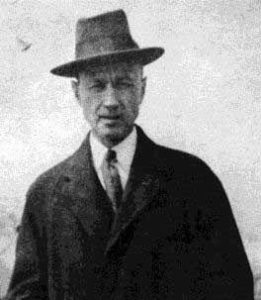On May 9, 11, and 12, the Houston Symphony concludes its season-long exploration of Charles Ives’ groundbreaking Symphony No. 4. In this post, discover the work’s otherworldly finale, the ultimate goal of Ives’ spiritual vision. You can learn more about the first, second, and third movements in previous posts. Get tickets and more information here.

Ives’ Fourth Symphony is his crowning achievement, the summation of all he had accomplished as a composer. Begun around 1910, Ives labored over it for many years, refining and altering the score well into the 1920s. The symphony, a marvel of modernist musical techniques, would never be performed in its entirety during Ives’ lifetime, but the first two movements were performed in 1927 and accompanied by a program note that was certainly informed by and quite possibly ghost-written by Ives. The note explains that the first movement poses “the searching questions of What? and Why? which the spirit of man asks of life,” and that “The three succeeding movements are the diverse answers in which existence replies.”
The movements of the symphony thus represent a kind of spiritual progression. The second movement parodies false spirituality with a tone poem about a luxury express train that purportedly takes paying passengers to heaven, but in fact goes straight to hell. The third movement, a soulful fugue, is “an expression of the reaction of life into formalism and ritualism”—generally interpreted as a depiction of organized religion (namely the Protestant Christianity Ives was raised with). The ultimate revelation comes in the final movement.
In his memos, Ives quotes the program note as saying, “The last movement is an apotheosis of the preceding content, in terms that have to do with the reality of existence and its religious experience,” although this sentence curiously does not appear in the note. In his own words, Ives goes on, saying “And I always think of it somehow in connection with a Communion Service, especially the memory of one, years ago, in the old Redding Camp Meetings,” outdoor religious revivals held in rural 19th century America. Ives witnessed one of the last of these great meetings as a boy in 1878, an event that left a profound impression on him and his music.
The movement begins with a group of percussion instruments separate from the rest of the orchestra; these instruments all play repeating rhythmic patterns of different lengths at a tempo that is related to but different from that of the rest of the orchestra (thus requiring a second conductor). This strange, indistinct march arises out of nothing, beginning our progress toward the divine:
The orchestra begins soon after with fragmentary melodic motifs. Most of them are based on protestant hymn tunes, the main one being Bethany (the melody for “Nearer My God to Thee”). A fragment of Bethany can be clearly heard when the “Distant Choir,” an ensemble of violins and harp, begins to play.
These overlapping, fragmentary hymns occur in several keys at once, but unlike the harsh clashes of the second movement, these dissonances create an eerie, ethereal texture—as if the hymns are distant memories or the beginning of a revelatory vision. The orchestra begins a long, gradual crescendo, and the music becomes increasingly intense. At last, the tension breaks, and we hear the otherworldly sound of what Ives called an “ether organ” playing “Nearer My God to Thee.” Scholars are not entirely sure what instrument Ives intended here, but the part is usually played today by the ondes martinet or a synthesizer (in the video above, a theremin is used). An angelic choir then vocalizes the end of the hymn, completing the prophetic vision, and the music slowly fades away. —Calvin Dotsey
Don’t miss the finale of Ives’ Symphony No. 4 on May 9, 11, and 12! Visit houstonsymphony.org for tickets and more information.
We want to hear from you! Tell us what you think in the comments below.



